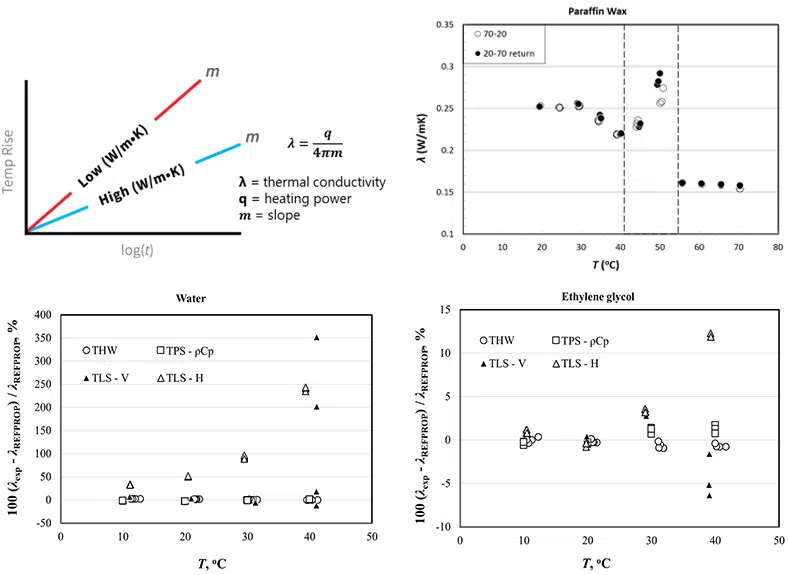
August 25, 2023
The convective heat transfer coefficient, a crucial parameter in determining the efficiency of heat transfer between a fluid and a solid surface, is related to the thermal conductivity of the fluid. By accurately measuring thermal conductivity, Newtonian liquids’ convective heat transfer coefficients are calculated using the Nusselt number correlation [2], and this has applications in designing cooling systems, heat exchangers, and other vital components in various industries.
Transient Hot Wire (THW) is the prominent technique for accurately and precisely measuring thermal conductivity in liquids. With this method, we can delve deeper into the thermal transport characteristics of liquids, providing invaluable insights for developing efficient cooling systems and thermal management solutions.
Table of Contents
The THW method is an absolute technique for measuring the thermal transport properties of liquids and nanofluids following the ASTM D7896-19 standard [3]. By employing a heated wire immersed in the liquid, the thermal conductivity of the liquid can be precisely determined. The temperature-time profile obtained from testing can determine the thermal transport properties. The following section provides a brief background on the origins of hot wire methods for thermal conductivity measurements.
The origins of employing heated wires to observe heat transfer in fluids date back to 1845-1848 when Sir Robert Grove illustrated gaseous conduction by immersing incandescent (glowing) hot Platinum wire in the Hydrogen environment[4]. The wire lost its incandescence upon immersion, indicating heat loss by conduction.
In 1888, Schleiermacher constructed the first hot wire instrument with spring-loaded taut platinum wire in a horizontal glass cylinder to measure the thermal conductivity of gases. Weber further modified the design in 1917 to reduce sources of errors such as convection by rotating the instrument to a vertical configuration.
In 1931, Stalhane and Pyk designed the first “transient hot wire” instrument by winding constantan wire around a tube with a thermometer. They developed an empirical relation to calculate the thermal conductivity of solids, powders, and some liquids by measuring temperature rise over time. Further design modifications followed subsequently.
In 1971, Davis et al. proposed a modified design with very thin and shorter wire with measurement times of 1 to 10 seconds, made possible using a digital voltmeter. Haarman employed a Wheatstone bridge to measure the resistance difference of two wires in 1971.
Introducing high-precision electronics (Wheatstone bridge, electronic switches, and counters) reduced the experimental run times by 10-fold, eliminated the convection effects, and improved the accuracy of resistance and time measurements to up to 6 decimal values, allowing higher precision and much lower uncertainties. The attributes mentioned above form the core attributes of modern THW instruments. Thermtest THW-L1 liquid thermal conductivity meter is the benchmark of liquid TC measurements [3].
To determine the fluid’s temperature coefficient, submerge a thin wire in the fluid and expose it to a voltage change. Measure the temperature increase of the wire, which functions as both a heat source and a resistance thermometer. The temperature field surrounding the wire can be described through Fourier’s conduction equation.

Solving this equation using appropriate boundary conditions result in the following equation for temperature rise:

Continuous temperature rises measurements as a function of ln(time) results in a linear plot. The slope of temp rise vs ln(t) line can be used to calculate thermal conductivity of fluid.
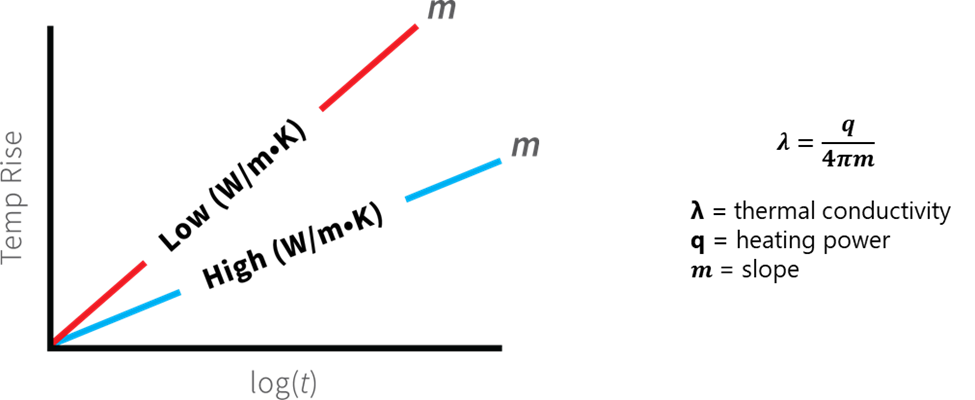
Figure 1. Thermal Conductivity Calculation procedure using THW results.
Alternatively, measuring the temperature rise at two distinct time intervals on the linear portion of the curve can be used to calculate thermal conductivity as follows:

In the THW method, we fully immerse a thin Platinum (L-1) or Alumet (L-2) wire, approximately 0.1mm thick and 40-60 mm long, into the liquid. We contain the liquid specimen in a sampling cell. Figure 2 displays the sensor assembly with the wire. We heat the liquid sample by sending a short current pulse (typically 1 second) through the wire and then measure the temperature change over time.
For THW-L1, the Pt wire serves two purposes: it supplies a constant heat flux as an A-line source and acts as a resistance temperature detector (RTD) to measure temperature changes over time.
For THW-L2, we use a separate Pt100 RTD to measure the temperature change in the medium.
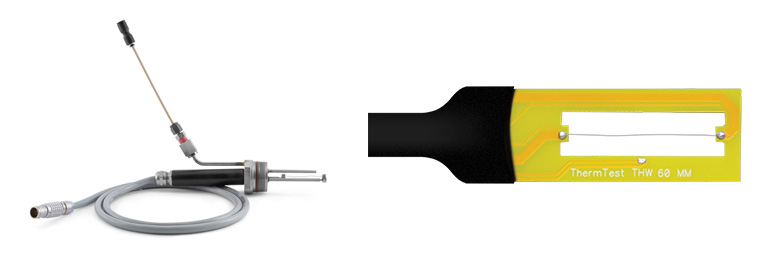
Figure 2. THW-L1 Sensor and THW-L2 Sensor
This section demonstrates the procedure for measuring the Thermal Conductivities of automobiles’ vital heat transfer fluids (HTFs): motor oil 10W-30 and transmission oil. These fluids play a crucial role as both lubricants and coolants in cars. They keep the sub-systems clean and facilitate efficient heat transfer from components such as valves, pistons, bearings, and gears within engine and transmission systems.
For testing, the THW-L1 sensor is used with an integrated temperature device. This setup enables precise thermal conductivity measurements in the 10 to 200°C (the temperature range can be further expanded to -150 to 300°C).
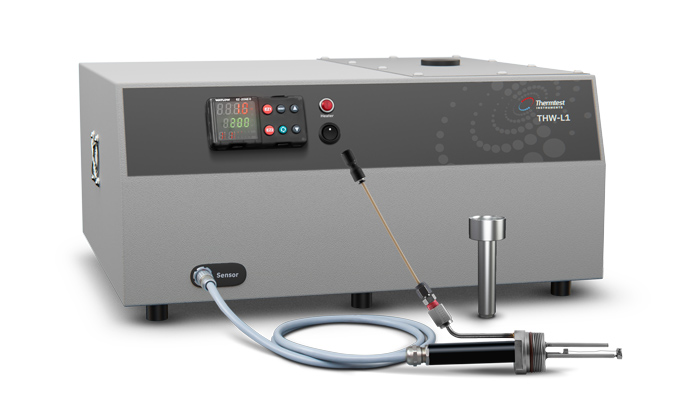
Figure 3. THW-L1
Process of conducting a THW measurement using Thermtest’s THW-L1.
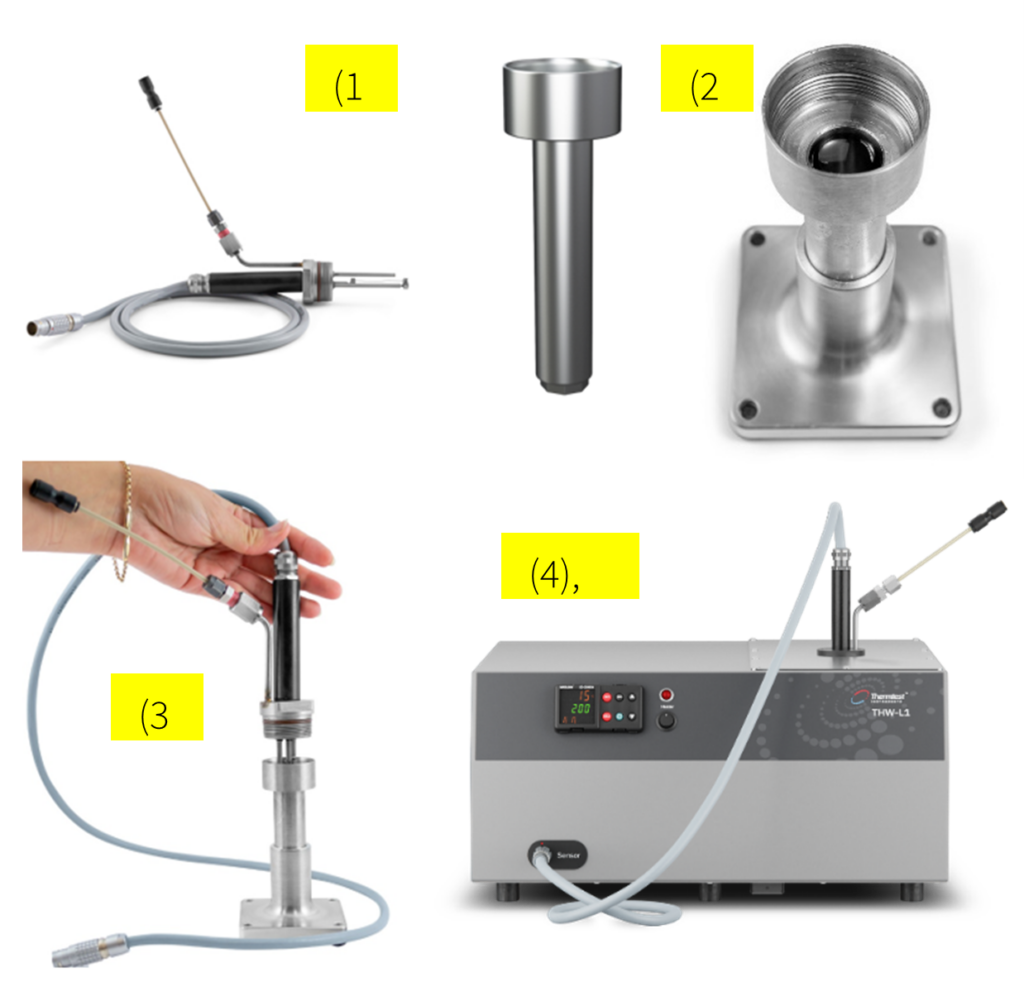
Figure 4. THW Sample set up procedure. The numbers in the figure above correspond to the steps mentioned above.
The thermal transport properties of both 10W-30 motor oil and transmission oil are measured using THW-L1 in the temperature range of -40 to 150 °C, with measurements taken at 10°C intervals. As depicted in Figure 5, both motor and transmission oils used in this test have similar thermal transport properties and exhibit parallel trends with temperature variation.
The results indicate that as the temperature ascends from -40 °C to ambient temperature (25 °C), the thermal conductivity of the oils experiences an approximate 10% reduction. The diminution continues, and the thermal conductivity decreases by 10% as the oil heats up to 150 °C.
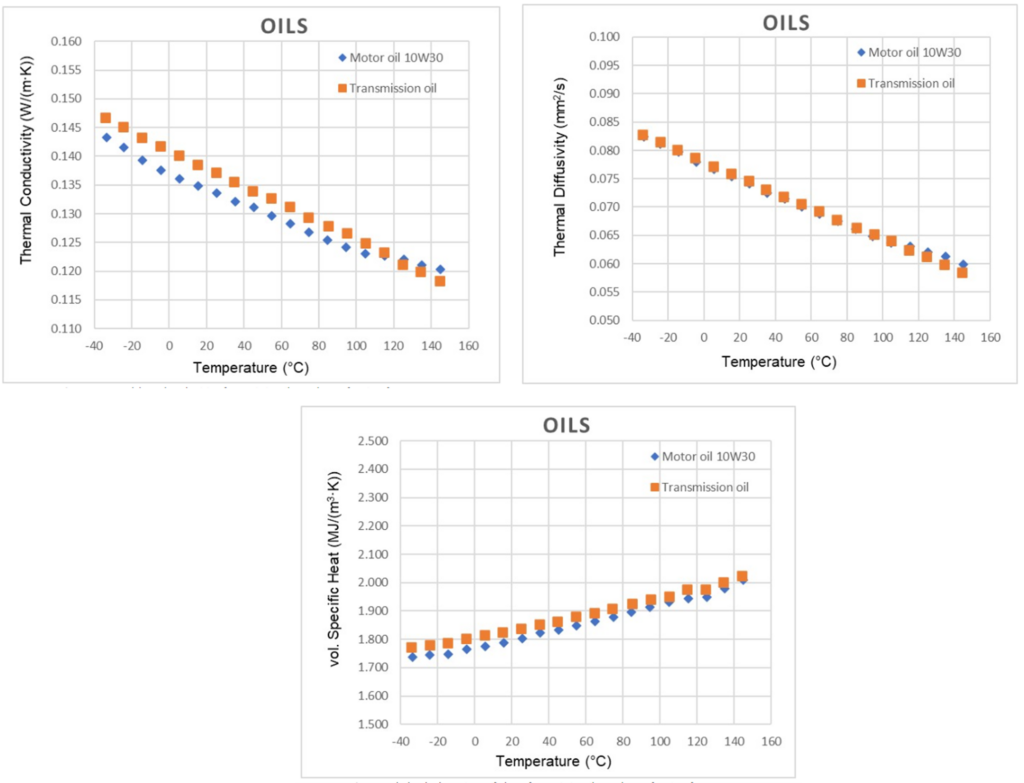
Figure 5. Thermal Conductivity, Thermal Diffusivity and Volumetric Heat Capacity of automotive fluids measured using THW-L1.
There are several techniques implemented for liquid TC measurement. The THW method is a primary approach due to the fluid-specific working theory for the measurements. This includes an extensive theoretical framework to eliminate contact resistance and errors arising from convective and radiation heat loss[5]. Key advantages include direct contact between fluid and wire, rapid measurement times and ease of use.
In contrast, alternative commercial methods such as Transient Line Source (TLS), Transient Plane Source (TPS), Laser Flash Analysis (LFA), 3ω and Guarded Heat Flow Method (GHFM), available for liquid testing[6] are mainly intended for solid samples. Liquid sample measurement with these methods extends beyond their primary design purpose.
This section presents a brief overview of alternative liquid testing methods.
The THW method offers accurate and rapid measurements (~1 sec) without convective effects. It is an absolute method, requires minimal calibration and employs a constant current source.
A comparison of strengths and weaknesses of testing fluids using transient techniques based on wire, line and plane source is provided in Table 1.
| THW | TLS | TPS | |
| Working theory | Based on fluid measurement (ASTM 7896-19) |
Based on solid sample measurement (ASTM D5334-22a) |
Based on solid sample measurement (ISO 22007-2) |
| Measurement time | 1 second | Variable | Variable |
| Sensor | Thin wire in contact with fluid. No heat loss | Needle Probe | Plane |
Table 1. Comparison between wire, line, and plane sources for liquid thermal conductivity measurements.
Figure 6 illustrates the percentage deviation between measured (from THW, TLS and TPS) and reference thermal conductivities for water and ethylene glycol. Among these techniques, the THW method consistently demonstrated the most minor deviation (<2%) from the reference values. Other methods exhibited significantly higher variations, especially at elevated temperatures.
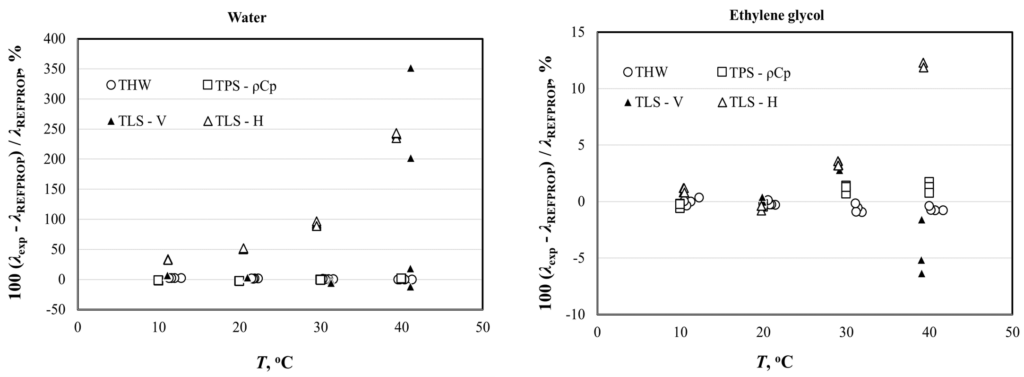
Figure 6. Illustration of variances at different testing temperatures in thermal conductivity measurements of water and ethylene glycol using transient methods.
THW measurements are critical for quantifying the thermal conductivity of fluids, which holds immense significance in heat transfer applications across various sectors. Industries ranging from solar energy automotive to power electronics rely on fluid dynamics for effective thermal management. For example, engineering applications involving HTFs in automotive systems, cutting-edge technologies like nanofluids, nano lubricants, and Phase Change Materials (PCMs) require precise thermal conductivity measurements to determine the accurate thermal distribution.
The methodology employed for measuring the thermal conductivities of typical fluids, such as cutting fluids and HTFs, closely aligns with the process used for automotive fluids in section 2.3.2. However, some unique scenarios exist where the THW technique proves extremely valuable and requires specific custom-designed equipment. These cases are detailed below.
Heat conduction in powder particles with sizes ranging from nano to micrometres has applications across various industries, such as food processing, pharmaceuticals, additive manufacturing, and powder coatings. Due to powders’ tiny size and flow dynamics, conventional thermal conductivity methods for solids could be more effective. THW-L1 emerges as a solution to measure the thermal conductivity of powders with varying mean particle sizes. This is achieved using a custom-designed ambient density powder cell, as shown in Figure 7.
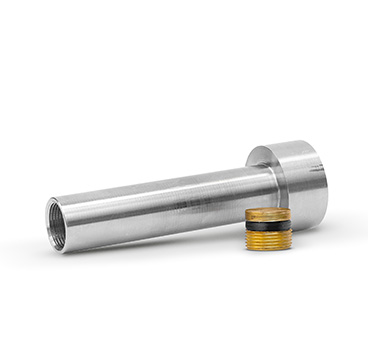
Figure 7a. Ambient Density Powder Cell.
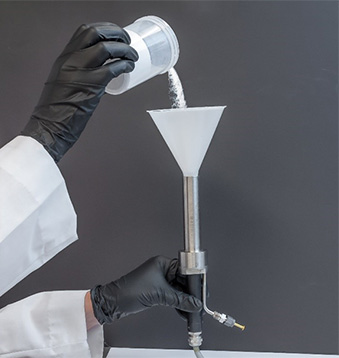
Figure 7b. Powder filling procedure.
Three distinct powders, varying in particle sizes from 7nm to 60μm, were tested using THW-L1 in a custom-designed powder cell. Testing is carried out at 18°C for 5 seconds. Figure 8 depicts the thermal conductivity results of the powders as a function of particle size. Thermal conductivity measurements can be obtained for powders with particles as low as 7nm to as high as 60μm.
The thermal conductivities of the powders are significantly lower (by factors of 30-800) than their bulk counterparts (Thermal Conductivity of Alumina: 35-40 W/m/K, Silica: 1-1.5 W/m/K Boron Nitride: >50 W/m/K). The divergence stems from the inherent interparticle voids in powders filled with air. This can be visualized as the solid particles dispersed within a continuous gaseous medium (air). When measuring powders, we effectively measure the thermal conductivity of a two-phase medium – solid powder and gaseous air.
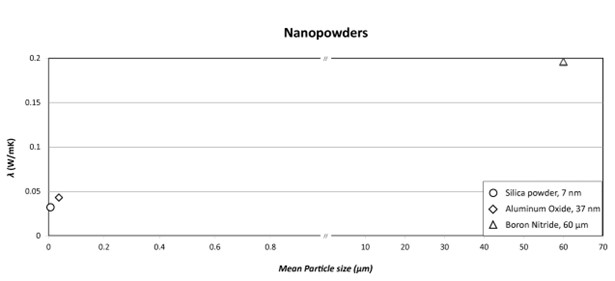
Figure 8. Thermal conductivity measurements of various powders of varying particle size.
Since air is an insulator, the air pockets’ high thermal resistance dramatically reduces the powders’ overall conductivity. Moreover, this phenomenon influences the sensor-powder contact, as the proportion of actual powder in contact with the sample diminishes. The powders’ thermal conductivity depends on the powder density, packing efficiency, volume fraction of gas, gas pressure, particle size distribution and shape (morphology)[7].
A detailed description of powder thermal conductivity measurement can be found in the following Application Sheet: Thermal Conductivity of powders with THW-L1.
Nanofluids are an advanced class of colloids consisting of dispersed nanoparticles (size: 1-100nm) in a heat transfer liquid. Nanofluids are attracting significant interest in cooling applications due to their ability to dramatically increase the thermal conductivity of base liquid with minute additions. For example, a 0.3 vol% addition of Copper nanoparticles (~10nm diameter) can increase the thermal conductivity of ethylene glycol by 40%[8]. Applications of Nanofluids in various fields are outlined in Table 2.
| Heat Transfer | Electronics | Automotive | Biomedical |
| Heat exchangers | Cooling microchips | Nanolubricants | Sensing and Imaging |
| Industrial Cooling | Microscale fluids appl. | Nanofluid coolant | Cancer Treatment |
Table 2. Nanofluid applications
This section uses the previously tested 10W30 motor oil as the base fluid (Section 2.3.2) and powders BN and Silica as the filler suspensions (Section 3.2.1) to prepare nanofluids. The results of the THW tests are presented in Figure 9.
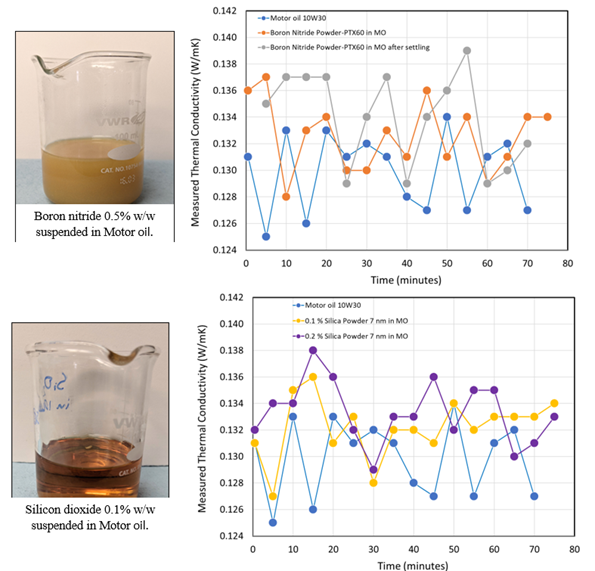
Figure 9. Thermal conductivity measurements of nanofluids
The thermophysical characteristics and properties of the dispersed nanoparticles influence the quality of thermal conductivity measurements in nanofluids. The overall thermal conductivity of a nanofluid is influenced by the size, shape, density and concentration of the nanoparticles, degree of agglomeration and viscosity of the base liquid[6].
For a comprehensive understanding of the nanofluids and nano lubricants testing using the THW method, please refer to the webinar: Thermal conductivity of nanofluids and nano lubricants using THW and application sheet: Thermal conductivity and viscosity of carbon black nanofluids.
Phase Change Material (PCM) is a substance that can absorb or release a significant latent heat of fusion during its phase transition. This is achieved at operating temperatures through repeated cycles of melting (absorption) and crystallization (release)[9].
PCMs are ideal for latent heat thermal energy storage (LHTES) applications if they have high latent heat, high specific heat, high thermal conductivity, and low density. In LHTES applications, knowledge of PCM thermal conductivity is crucial for understanding thermal management. This includes accurate thermal conductivity measurements in both liquid and solid phases, as the phase transition can significantly impact thermal behaviour[9].
PCM measurements are often reported for either liquid or solid phases. In some cases, liquid and solid-state thermal conductivity measurements are reported but measured with different instruments, leading to inconsistencies due to separate instruments.
Using THW, the thermal conductivity of PCM can be measured in both phases in a single experiment, offering consistent measurements through phase change, reducing experimental costs, uncertainties, and time investment. The continuous measurement also reveals PCM phase transition illustrated by the dramatic change in thermal conductivity.
As shown in the figure, a specialized spring-loaded cell is designed for PCM testing in THW. This unique spring design allows sample expansion and contraction (up to 15%) while ensuring the sample is in constant contact with the THW wire during measurement.
PCM testing with the custom paste cell in THW is demonstrated using paraffin wax. Paraffin waxes (Melting Point = 40-60 °C) are most suited for most PCM applications at room temperature or slightly elevated temperatures. Paraffins are straight-chain alkanes (CnH2n+2) where n =20-40.
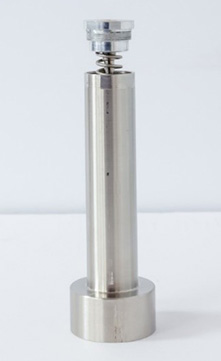
Figure 10a. PCM Cell.

Figure 10b. Paraffin Wax
The experiment’s temperature range is 20-70°C to accommodate both solid and liquid phase measurements during testing. Paraffin wax is initially heated to 70 °C and poured into the cell. Testing is conducted from 70°C to 20°C (cooling cycle). Then, the reverse measurements are taken by heating the sample to 70 °C (heating cycle).
The THW-L1 software automatically controls isothermal steps of temperature. The results demonstrate excellent repeatability, as shown in the below figure. Additionally, around 50°C, a dip in thermal conductivity of about 45% can be observed when the paraffin wax transforms from solid to liquid phase.
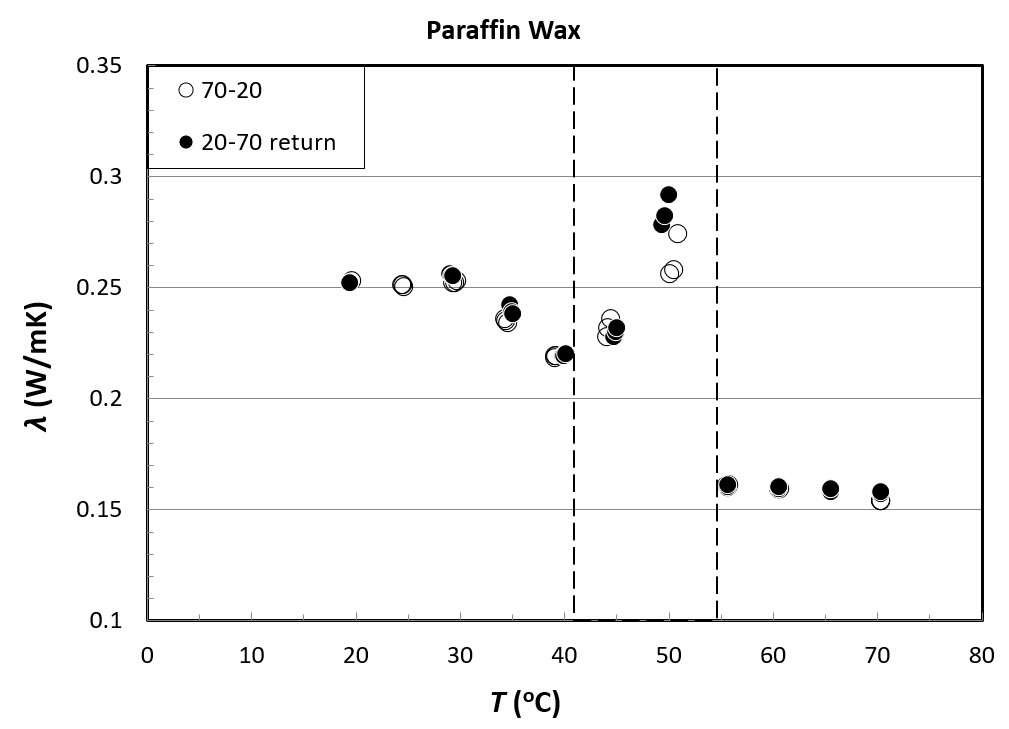
Figure 11. Thermal conductivity of Paraffin wax (PCM) using the THW and PCM cell.
The following Application Sheet provides a detailed explanation of the testing process: Thermal Conductivity of Paraffin Wax. For additional understanding of the measuring PCM thermal conductivity using THW, refer to the following Webinar: PCM for Energy Storage.
While convection is commonly associated with heat transfer in liquids, the thermal conductivity of liquids plays a vital role in governing heat transfer efficiency. The THW method serves as a primary measurement tool to accurately measure the thermal conductivity of liquids, providing valuable insights for various industrial applications.
With the accelerated growth in material development and evolution of novel material paradigms such as nanofluids and phase change materials, there is a growing need for commercial testing to develop novel strategies to meet this increasing demand. Thermtest THW equipment such as THW L-1 is evolving with a focus on customer needs by developing innovative products such as customized Powder and PCM testing cells.
[1]Gómez-Villarejo, R., Martín, E. I., Navas, J., Sánchez-Coronilla, A., Aguilar, T., Gallardo, J. J., Alcántara, R., De los Santos, D., Carrillo-Berdugo, I., and Fernández-Lorenzo, C., 2017, “Ag-Based Nanofluidic System to Enhance Heat Transfer Fluids for Concentrating Solar Power: Nano-Level Insights,” Applied Energy, 194, pp. 19–29.
[2] Buschmann, M. H., Azizian, R., Kempe, T., Juliá, J. E., Martínez-Cuenca, R., Sundén, B., Wu, Z., Seppälä, A., and Ala-Nissila, T., 2018, “Correct Interpretation of Nanofluid Convective Heat Transfer,” International Journal of Thermal Sciences, 129, pp. 504–531.
[3] “Standard Test Method for Thermal Conductivity, Thermal Diffusivity, and Volumetric Heat Capacity of Engine Coolants and Related Fluids by Transient Hot Wire Liquid Thermal Conductivity Method” [Online]. Available: https://www.astm.org/d7896-19.html. [Accessed: 03-Aug-2023].
[4] Assael, M. J., Antoniadis, K. D., and Wakeham, W. A., 2010, “Historical Evolution of the Transient Hot-Wire Technique,” Int J Thermophys, 31(6), pp. 1051–1072.
[5] Perkins, R. A., Roder, H. M., and Nieto de Castro, C. A., 1991, “A High-Temperature Transient Hot-Wire Thermal Conductivity Apparatus for Fluids,” J Res Natl Inst Stand Technol, 96(3), pp. 247–269.
[6] Souza, R. R., Faustino, V., Gonçalves, I. M., Moita, A. S., Bañobre-López, M., and Lima, R., 2022, “A Review of the Advances and Challenges in Measuring the Thermal Conductivity of Nanofluids,” Nanomaterials (Basel), 12(15), p. 2526.
[7] “Phys. Rev. B 80, 024202 (2009) – Model of Thermal Conductivity in Powder Beds” [Online]. Available: https://journals.aps.org/prb/abstract/10.1103/PhysRevB.80.024202. [Accessed: 09-Aug-2023].
[8] Eastman, J. A., Choi, S. U. S., Li, S., Yu, W., and Thompson, L. J., 2001, “Anomalously Increased Effective Thermal Conductivities of Ethylene Glycol-Based Nanofluids Containing Copper Nanoparticles,” Applied Physics Letters, 78(6), pp. 718–720.
[9] Velliadou, D., Antoniadis, K. D., Assimopoulou, A. N., Assael, M. J., and Wakeham, W. A., 2022, “Accurate Measurements of the Thermal Conductivity of Hexadecan-1-Ol and Octadecan-1-Ol in the Solid and Liquid Phases,” Int J Thermophys, 43(8), p. 124.